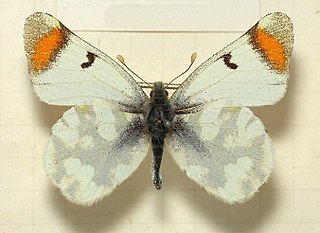
The Pieridae are a large family of butterflies with about 76 genera containing about 1,100 species, mostly from tropical Africa and tropical Asia with some varieties in the more northern regions of North America and Eurasia. Most pierid butterflies are white, yellow, or orange in coloration, often with black spots. The pigments that give the distinct coloring to these butterflies are derived from waste products in the body and are a characteristic of this family. The family was created by William John Swainson in 1820.

Pieris bryoniae, the dark-veined white or mountain green-veined white, is a Palearctic butterfly of the family Pieridae.

Anthocharis belia, the Moroccan orange tip, is a butterfly of the family Pieridae. It is found in northwestern Africa. The length of the forewings is 18–20 millimetres (0.7–0.8 in).

Anthocharis euphenoides, the Provence orange tip, is a species of butterfly in the family Pieridae. It is found in the Iberian Peninsula, in the south of France and in Italy in the Abruzzo. There are a few records from Switzerland. Its caterpillars use Biscutella as their food source.

Euchloe crameri, the western dappled white, is a butterfly in the family Pieridae.

The Pierinae are a large subfamily of pierid butterflies. The subfamily is one of several clades of butterflies often referred to as the whites.

The tribe Anthocharini is one of the subdivisions of the insect order Lepidoptera, which includes the moths and butterflies. It is a further subdivision of the butterfly family Pieridae and subfamily Pierinae; formerly it was considered a subfamily on its own, Anthocharinae. This tribe includes many, but not all, of the orangetip butterflies.

The sooty orange tip is a Palearctic Pieridae butterfly that has a range that extends through southern Europe, southwest Europe, northern Africa, East Kazakhstan and Asia Minor. Global warming currently seems to be extending its range to the north. The habitat consists of open flowery grasslands amongst hills.

Euchloe ausonides, the large marble or creamy marblewing, is a species of butterfly that occurs in western North America. It lays eggs on the terminal flower buds of a variety of plants in the mustard family, including introduced Eurasian species, and the larvae feed on the buds, flowers and fruit of these plants. In California, it has witnessed population declines since the 1980s, especially in the Central Valley and the Bay Area. In Washington, subspecies the island marble butterfly was listed as an endangered species under the Endangered Species Act in 2020.

Euchloe simplonia, the mountain dappled white, is a butterfly found in the mountainous regions of Western Europe. Its main foods are Sinapis, Isatis, Aethionema, Iberis and Biscutella species. Though data are lacking, it is believed that the species is restricted to a small area of the western Alps and is endangered in Europe. The species is closely related to Euchloe naina, and cross-breeding experiments suggest that E. nania may be a subspecies, though this is contested on morphological grounds.

Euchloe is a genus of pierid butterflies from the orangetip tribe (Anthocharini). They are Holarctic in distribution, with most species in Europe, Central Asia, and North America. Like other Anthocharini, the American species are usually called marbles; the Old World species are known as dappled whites.

Parnassius apollonius is a member of the snow Apollo genus Parnassius of the swallowtail family, Papilionidae. It is found in central and south Kazakhstan, the south Altai, Saur, Tarbagatai, Dzhungarsky Alatau, Tian-Shan, Ghissar-Darvaz, the Pamirs-Alai and west China.

Polyommatus eros, the Eros blue or common meadow blue, is a species of blue butterfly found in the Palearctic.

Athamanthia is an Eastern Palearctic genus of butterfly in the family Lycaenidae. Athamanthia is differentiated from Lycaena by characters of the male genitalia.

Euchloe tagis, the Portuguese dappled white, is a butterfly in the family Pieridae.

Polyommatus thersites, the Chapman's blue, is a butterfly in the family Lycaenidae. It is found in southern Europe, Morocco, Lebanon, Asia Minor, Iran and across the Palearctic to Siberia and Tian Shan.

Pseudochazara hippolyte is a species of butterfly in the family Nymphalidae. It is confined from the southern Urals across Kazakhstan and northern Tian-Shan to Transbaikalia, Mongolia and northern Tibet.

Vladimir Viktorovich Dubatolov is a Russian entomologist, lepidopterist, Doctor of Biological Sciences, full member of the Russian Entomological Society, member of the European Lepidopterological Society, curator of the insect collection of the Siberian Zoological Museum, leading researcher at the Institute of Systematics and Ecology of Animals SB RAS (Novosibirsk), leading researcher of the Zapovednoye Priamurye. He has described a number of zoological taxa. The names of these taxa are accompanied by the author abbreviation "Dubatolov".

















